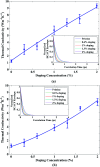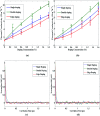Thermal transport characterization of carbon and silicon doped stanene nanoribbon: an equilibrium molecular dynamics study
- PMID: 35548196
- PMCID: PMC9085883
- DOI: 10.1039/c8ra06156d
Thermal transport characterization of carbon and silicon doped stanene nanoribbon: an equilibrium molecular dynamics study
Abstract
Equilibrium molecular dynamics simulation has been carried out for the thermal transport characterization of nanometer sized carbon and silicon doped stanene nanoribbon (STNR). The thermal conduction properties of doped stanene nanostructures are yet to be explored and hence in this study, we have investigated the impact of carbon and silicon doping concentrations as well as doping patterns namely single doping, double doping and edge doping on the thermal conductivity of nanometer sized zigzag STNR. The room temperature thermal conductivities of 15 nm × 4 nm doped zigzag STNR at 2% carbon and silicon doping concentration are computed to be 9.31 ± 0.33 W m-1 K-1 and 7.57 ± 0.48 W m-1 K-1, respectively whereas the thermal conductivity for the pristine STNR of the same dimension is calculated as 1.204 ± 0.21 W m-1 K-1. We find that the thermal conductivity of both carbon and silicon doped STNR increases with the increasing doping concentration for both carbon and silicon doping. The magnitude of increase in STNR thermal conductivity due to carbon doping has been found to be greater than that of silicon doping. Different doping patterns manifest different degrees of change in doped STNR thermal conductivity. Double doping pattern for both carbon and silicon doping induces the largest extent of enhancement in doped STNR thermal conductivity followed by single doping pattern and edge doping pattern respectively. The temperature and width dependence of doped STNR thermal conductivity has also been studied. For a particular doping concentration, the thermal conductivity of both carbon and silicon doped STNR shows a monotonic decaying trend at elevated temperatures while an opposite pattern is observed for width variation i.e. thermal conductivity increases with the increase in ribbon width. Such comprehensive study on doped stanene would encourage further investigation on the proper optimization of thermal transport characteristics of stanene nanostructures and provide deep insight in realizing the potential application of doped STNR in thermoelectric as well as thermal management of stanene based nanoelectronic devices.
This journal is © The Royal Society of Chemistry.
Conflict of interest statement
There are no conflicts to declare.
Figures








Similar articles
-
Thermal transport characterization of stanene/silicene heterobilayer and stanene bilayer nanostructures.Nanotechnology. 2018 May 4;29(18):185706. doi: 10.1088/1361-6528/aaaf17. Epub 2018 Feb 13. Nanotechnology. 2018. PMID: 29438099
-
Numerical characterization of thermal transport in hexagonal tungsten disulfide (WS2) nanoribbons.Nanotechnology. 2024 Jul 12;35(39). doi: 10.1088/1361-6528/ad5a9f. Nanotechnology. 2024. PMID: 38906122
-
Diffusive nature of thermal transport in stanene.Phys Chem Chem Phys. 2016 May 25;18(21):14257-63. doi: 10.1039/c5cp07957h. Phys Chem Chem Phys. 2016. PMID: 27169141
-
Lateral and flexural thermal transport in stanene/2D-SiC van der Waals heterostructure.Nanotechnology. 2020 Dec 11;31(50):505702. doi: 10.1088/1361-6528/abb491. Nanotechnology. 2020. PMID: 33006320
-
Phonon thermal conductivity of the stanene/hBN van der Waals heterostructure.Phys Chem Chem Phys. 2021 May 12;23(18):11028-11038. doi: 10.1039/d1cp00343g. Phys Chem Chem Phys. 2021. PMID: 33942827
Cited by
-
Molecular dynamics investigation of the thermal behaviors of magnesium oxide ceramics at different pressures and temperatures.J Mol Model. 2022 Oct 14;28(11):361. doi: 10.1007/s00894-022-05302-9. J Mol Model. 2022. PMID: 36239819
-
First-principles study of the effect of S-atom doping on the optoelectronic properties of stanene.J Mol Model. 2024 Apr 1;30(4):115. doi: 10.1007/s00894-024-05905-4. J Mol Model. 2024. PMID: 38557702
References
LinkOut - more resources
Full Text Sources

